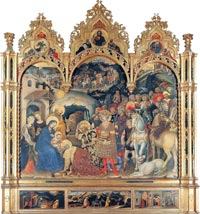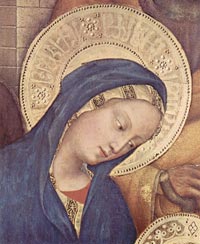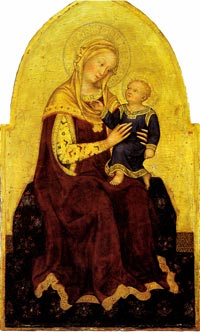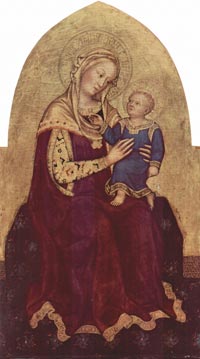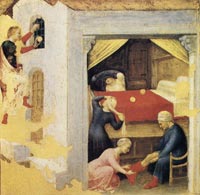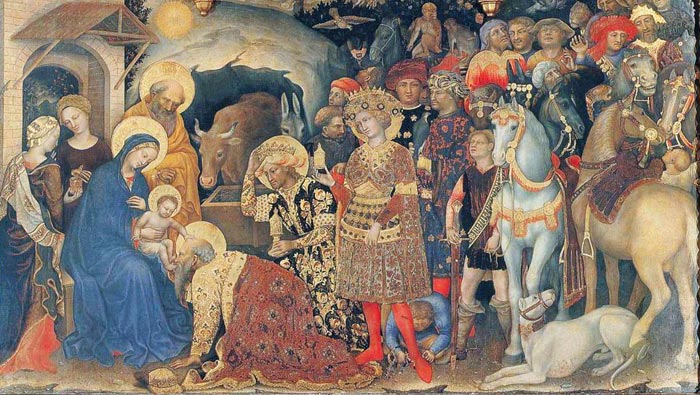 |
Gentile da Fabriano, Adoration of the Magi (detail), (1423) Tempera on wood, 300 x 282 cm Galleria degli Uffizi, Firenze |
| Gentile da Fabriano, c. 1370 - 1427 |
Gentile da Fabriano, or Gentile di Niccolò di Giovanni di Massio (c. 1370 – c. 1427) was an Italian painter known for his participation in the International Gothic style. Gentile was born in or near Fabriano, near Ancona in the Marche. His mother died some time before 1380 and his father, Niccolò di Giovanni Massi, took monastic vows in the monastery of Santa Caterina in Castelvecchio, a fact that suggests that Gentile was fully independent, including financially, by that time. His father died in 1385. |
The works that can be assigned to this first phase of the artist's career — like the little Madonna and Two Saints (Museo Civico, Pavia), the Madonna and Two Saints with Donor for the church of San Niccolò or Santa Caterina in Fabriano (Gemäldegalerie, Berlin), the Madonna Enthroned with Angel Musicians for San Domenico in Perugia (Pinacoteca Nazionale, Perugia), and the polyptych for the church of Valle Romita near Fabriano (Pinacoteca di Brera, Milan) — suggest that he was trained outside of Fabriano. Some think his training was in Lombardy, others in Venice, but it certainly ran parallel with the refined, up-to-date late Gothic figurative tradition of Giovannino de' Grassi, Michelino da Besozzo, Stefano da Verona, and the Lombard miniaturists of the tacuina sanitatis.Between 1414 and 1419 Gentile worked for Pandolfo Malatesta, signore of Brescia, where recently there have come to light some fragments of his frescoes in the chapel of the Palace of Broletto. In 1419 the painter asked Pandolfo for a safe-conduct for himself and his entourage to reach Rome. He stopped first in Fabriano, where he is documented in 1420, and in the fall of that year he rented a house in Florence, enrolled in the painters' guild in 1422, and resided in the district of Santa Trinità until 1425. In Fabriano (or perhaps in Florence, but on commissions originating in Fabriano) he painted a standard with the Coronation of the Virgin on the front (J. Paul Getty Museum, Los Angeles), and Saint Francis Receiving the Stigmata on the back (Fondazione Magnani in Traversetolo, near Parma). In 1423, for the sacristy of Santa Trinità in Florence, he painted his masterpiece, the Adoration of the Magi (now Galleria degli Uffizi, Florence). Commissioned by Palla Strozzi, this brilliant narrative spectacle is rich with sentiment, psychological observation, and an unusually detailed description of nature. For the church of San Niccolò Oltrarno in Florence he painted five panels, probably part of a larger complex (today preserved, in ruinous state, in the storerooms of the Gallerie Fiorentine), and the polyptych for the high altar, formerly signed and dated 1425, currently divided among various collections (National Gallery, London, on deposit from the Royal Collections; Uffizi, Florence; Pinacoteca Vaticana, Rome; National Gallery of Art, Washington).
|
|
||
The Adoration of the Magi, housed in the Uffizi Gallery in Florence, Italy, is considered his finest work, and has been described as "the culminating work of International Gothic painting".[1] The painting was commissioned by the Florentine literate and patron of the arts Palla Strozzi, at the arrival of the artist in the city in 1420. Finished three years later, it was placed in the new chapel of the church of Santa Trinita which Lorenzo Ghiberti was executing in these years. The works shows both the international and Sienese schools' influences on Gentile's art, mingled with the Renaissance novelties he knew in Florence. The panel portrays the path of the three Magi, in several scenes which start from the upper left corner (the voyage and the entrance into Bethlehem) and continue clockwise, to the larger meeting with the Virgin and the newborn Jesus which occupies the lowest part of the picture. All the figures wear splendid Renaissance costumes, brocades richly decorated with real gold and precious stones inserted in the panel. Gentile's typical attention for detail is also evident in the exotic animals, such as a leopard, a dromedary, some apes and a lion, as well as the magnificent horses and a hound. The frame is also a work of art, characterized by three cusps with tondoes portraying Christ Blessing (centre) and the Annunciation (with the Archangel Gabriel on the left and the Madonna on the right). The predella has three rectangular paintings with scenes of Jesus' childhood: the Nativity, the Flight into Egypt and the Presentation at the Temple (the latter a copy, the original being in the Louvre in Paris). [2] |
||
Typical of Gentile's early style is the polyptych (ca. 1400) from the convent of Valle Romita in Fabriano, in which Gentile displays the International Gothic love for naturalistic detail in the floral turf beneath the feet of the graceful, slender saints whose figures are swathed in rhythmic, linear drapery. The central panel, the Coronation of the Virgin, shows the love for calligraphic drapery so characteristic of Gentile's early style. Other noteworthy early works include the much damaged Madonna in Perugia and the Madonna with Saints and Donor in Berlin. Pseudo-Arabic script in the Virgin Mary's halo, detail of Adoration of the Magi (1423) by Gentile da Fabriano. The script is further divided by rosettes like those on Mamluk dishes. [1] |
||
| Gentile da Fabriano's patrons were princes, the church, and various city governments as well as the customary merchant clients. His art has a cosmopolitan flavor, in which brilliant color, textural richness, and ornamental pattern are combined.
In the Madonna and Child Enthroned, painted in Florence, Mary sits on a bench covered by floral material that falls onto an elaborately tiled floor. The elegantly attired figures are surrounded by four angels, barely visible, which have been incised into the gold-leaf background. In contrast to earlier devotional images in which the Madonna and Child appear as a celestial vision, the holy figures here appear very corporeal. As if to emphasize Mary's role as Divine Mother, the Christ Child gestures with his right hand toward the Latin word Mater inscribed on the collar of her mantle. The string in his other hand tethers a butterfly, a traditional symbol of Christ's resurrection from the tomb. Gentile's art is typical of the International Style, a manner of painting which became popular at courts throughout Europe in the late fourteenth and early fifteenth centuries. Characterized by a refined decorative elegance, a concern for continuous rhythms, and the lavish use of gold and bright colors, this aristocratic manner fused the stylized art of the Middle Ages with the emerging naturalistic interests of the Renaissance. |
||
| Gentile da Fabriano's patrons were princes, the church, and various city governments as well as the customary merchant clients. His art has a cosmopolitan flavor, in which brilliant color, textural richness, and ornamental pattern are combined. In the Madonna and Child Enthroned, painted in Florence, Mary sits on a bench covered by floral material that falls onto an elaborately tiled floor. The elegantly attired figures are surrounded by four angels, barely visible, which have been incised into the gold-leaf background. In contrast to earlier devotional images in which the Madonna and Child appear as a celestial vision, the holy figures here appear very corporeal. As if to emphasize Mary's role as Divine Mother, the Christ Child gestures with his right hand toward the Latin word Mater inscribed on the collar of her mantle. The string in his other hand tethers a butterfly, a traditional symbol of Christ's resurrection from the tomb. Gentile's art is typical of the International Style, a manner of painting which became popular at courts throughout Europe in the late fourteenth and early fifteenth centuries. Characterized by a refined decorative elegance, a concern for continuous rhythms, and the lavish use of gold and bright colors, this aristocratic manner fused the stylized art of the Middle Ages with the emerging naturalistic interests of the Renaissance. |
||
| This panel formed the centre of an altarpiece commissioned by a member of the Quaratesi family for the high altar of San Niccoló Oltrarno, Florence. It was flanked by Saints Mary Magdalene, Nicholas of Bari, John the Baptist and George. The predella showed scenes from the Life of Saint Nicholas. The Child holds what seems to be a daisy. The cloth of honour behind the Virgin is silver (now tarnished) glazed with red. (The Cloth of Honour is the length of material, often gold brocade, which is hung behind the seat on which the Virgin and Child are enthroned. There is sometimes an additional canopy above their heads). The highly decorative nature of the variously patterned luxury textiles, the elaborately tooled gold, and the delicate nature of the figures contrast strongly with the same subject painted by Masaccio a year later. The gable with God the Father is original but within a modern frame. Four panels of the predella of the polyptych are in the Vatican Museum. The work was considered one of the best among those painted by Gentile da Fabriano, whose signature appeared together with the date May 1425 in a lost text. It is therefore one of the last paintings done by the artist who died just two years later in Rome. The Quaratesi polyptych remained in the church until 1830 when it was dismantled and sold (The central panel with Our Lady enthroned with the Child is in Hampton Court in England, the four side panels with St. Mary Magdalene, St Nicholas of Bari, St John the Baptist and St George in the Uffizi Gallery in Florence; the fifth panel of the predella with the Pilgrims at the tomb of St Nicholas is in the National Gallery of Art of Washington). The episodes shown are: The birth of St Nicholas; Gift to the three poor girls; St Nicholas revives three youths put into brine and St Nicholas saves a ship from sinking. |
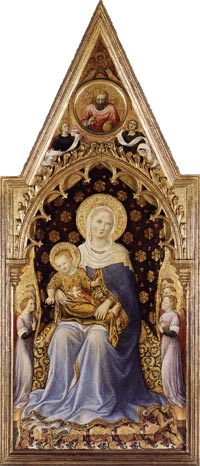 Gentile da Fabriano, The Quaratesi Madonna 1425, The National Gallery, Trafalgar Square, London |
|
| St. Nicholas and the Three Gold Balls. From the predella of the Quaratesi triptych from San Niccolo, Florence. 1425. Tempera on wood. Pinacoteca Vaticana, Vatican, Rome. The scene illustrates the episode in which Nicholas saved three impoverished girls from prostitution by tossing three gold balls through their window one night. Pictures of Nicholas often show three bags of gold next to him, and often these bags have become simply three disks or balls. The Three Gold Balls represent the gold given to provide dowries for the impoverished maidens. Nicholas' gold balls became the pawnbroker's symbol. Sometimes oranges or apples are used to represent the gold. |
||
The panel Pilgrims at the Tomb of St Nicholas of Bari also belonged to the predella of the dismembered Quaratesi Altarpiece. The last surviving work by Gentile da Fabriano documents, in this pilgrimage scene, an interesting chapter in the history of religion. It shows the viewer the pilgrimage to the tomb of St. Nicholas in Bari, the popularity of the pilgrimage site, and also, in the figure of the man front left, an instance of miraculous healing. Art in Tuscany | Gentile da Fabriano, Quaratesi Polyptych, 1425 |
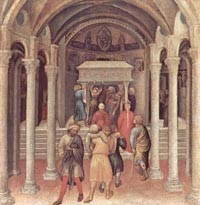 Gentile da Fabriano. A Miracle of St. Nicholas. From the predella of the Quaratesi triptych from San Niccolo, Florence. 1425. Tempera on wood. The National Gallery of Art, Washington, DC, USA. |
|
References Vasari, Giorgio. La vite del più eccellenti pittori, scultori e architetti. Gentile da Fabriano e il Pisanello. Ed. Adolfo Venturi. Florence, 1896 (originally 1568).
|
Residency in Tuscany for writers and artists | Podere Santa Pia
|
 |
Podere Santa Pia situated in panoramic position in the Maremma countryside
|
|
| This page uses material from the Wikipedia article Gentile da Fabriano, published under the GNU Free Documentation License. |

